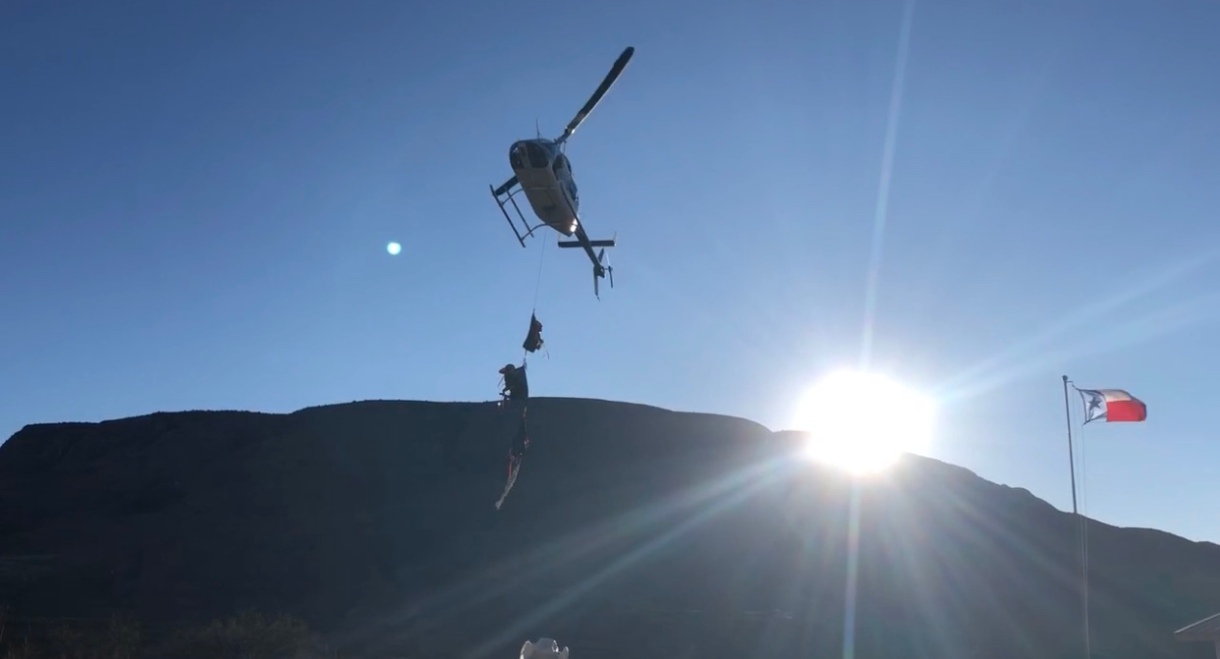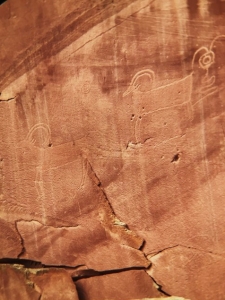Capturing Texas Bighorn Sheep (Video)

Barnett Youth Compound Bow Review
December 26, 2019
Eastern Turkey Release (Video)
January 1, 2020Texas Bighorn Capture at Elephant Mountain Wildlife Management Area (WMA)—The chuffing sound of helicopter blades sounded faintly in the distance.
As a crowd of biologists and technicians from the Texas Parks & Wildlife Department (TPWD), Tech Tech, and Sul Ross University, among others, looked upward, the helicopter appeared.
Flying above the 6,2000-foot peak of Elephant Mountain in this remote area of Brewster County, it looked blurry at first.

A pair of bighorns is safely brought to the ground as the sun rises over Elephant Mountain in Brewster County, TX. (Photo by Chester Moore, Jr.)
But upon approach, details became apparent, and so did it’s cargo.
Two desert bighorn sheep blindfolded and secured in safety gear hung from the helicopter and were soon gently placed on the ground.
After detachment, the ground crew quickly moved the sheep to tables to thoroughly examine them.
They gave the sheep everything from fecal examinations to blood tests and took tiny ear clippings for DNA records.
“I can’t believe I’m getting to see all of this,” said Reannah Hollaway, a first-year wildlife student at Texas Tech.
Reannah is part of our Wild Wishes® program that grants wildlife encounters to youth struggling with critical illness or loss of a parent or sibling.
As a high school senior, Reannah’s initial wish was to encounter sea turtles. But while attending her first school of choice in 2018, she reflected on her wish experience and decided to go into the conservation field.
In fall 2019, she transferred to Texas Tech and now dreams of working on behalf of wildlife.
When TPWD”s Project Leader of Trans Pecos WMAs, Mark Garrett, approached her with a GPS collar in hand, she wasn’t quite sure what was happening.
But as officials brought in a big ram, she realized she was getting to put collar it.
“This will give us much information on its movements and allow us a better understanding of what these sheep are doing after we move them to Black Gap Wildlife WMA,” Garrett said.

Reannah fits a radio collar on a desert bighorn ram. (Photo by Chester Moore, Jr.)
After overcoming a few understandable nerves, Hollaway enthusiastically fitted the collar and watched as the crew moved the ram into a transport trailer.
In the course of the next few hours, she took ear clippings and helped take a blood sample from several ewes.
Desert bighorn sheep restoration in Texas in many ways centers on Elephant Mountain WMA. Donated to TPWD in 1986 for sheep propagation, it has been highly productive for desert bighorns, and when the area reaches carrying capacity, TPWD officials move part of the herd to other locations that could use a population boost.
These efforts supported by groups like the Texas Bighorn Society, Wild Sheep Foundation, and Dallas Safari Club have seen bighorns reach a population of around 1,500 in the Trans Pecos.
And after years of importing sheep from states like Nevada, TPWD offcials are now able to use Texas sheep to stock available habitat.
“It’s exciting to see how so many people have rallied around the bighorn program, and we are always excited to be able to take sheep from one place to another to expand their range in the Trans Pecos,” said Froylan Hernandez Texas desert bighorn program leader.
While scanning the area for photo opportunities, I noticed Reannah looking into one of the transport trailers.
“He’s beautiful, and his number is 8,” she said, referring to the identifying ear tag.
“I think I’ll name him Brian. He looks like a Brian.”

“Brian” the bighorn-aka No. 8 is trailered and ready to be released at Black Gap WMA. (Photo by Chester Moore, Jr.)
The young lady looked at the gorgeous ram in awe, and in her eyes, I could see the same wonder that has kept me enthused about wildlife since I was a little boy.
When business is slow, assignments are challenging, and real-life issues settle in, these moments are what keeps someone who works with wildlife motivated.
As me, my wife Lisa and daughter Faith made the eight-hour trek from Alpine to the Houston area to bring Reannah home; the happenings of the day dominated the conversation.
The sheep were beautiful.
The people were kind and gracious.
The helicopter operation was incredible to witness.
And Reannah getting to take part in this process was unforgettable and inspired a young lady to move forward in her studies and life with enthusiasm.
Ancient pictographs created by first nations people like the Jornada Mogollon of Texas and Fremont Culture of Utah adorn rock walls and caves in the desert Southwest.

Bighorn images inscribed on rocks in Utah by the Fremont culture. (Photo courtesy National Park Service)
Among these rock paintings are striking images of bighorn rams.
It is not clear whether these first nations people hunted sheep, but their reverence was evident.
Today desert bighorns still inspire.
Whether it is wildlife journalists like myself, wildlife biologists, hunters, landowners, or an aspiring student like Reannah, these animals leave an imprint on the human spirit.
Their mere presences move us to make the world a better place for sheep and other wildlife.
Chester Moore, Jr.
![]()






